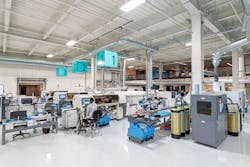Spearheading the Software-First Manufacturing Renaissance
The electronics manufacturing industry is experiencing a renaissance. With emerging technologies driving new factory capabilities, more production moving back onshore, and increased efforts to streamline once-complex supply chains, the future of the industry looks different moving into 2021 than it has in previous years. These shifts didn’t come gently; as the pandemic raged in early 2020, shutdowns caused major turbulence in manufacturing employment and operational demands, which required quick strategy reevaluations and adaptations.
Now, as some changes become standard and other aspects of the factory float back to normal, companies are using digital-first methods to meet the newfound demands and remain consistent with growth throughout the manufacturing sector. Being high-tech and highly agile is no longer optional; it’s now required to support larger technology innovation and growth across fast-growing markets—including MedTech, aerospace, consumer electronics, and more. Here, we dive into how the new trends in manufacturing are creating opportunities for growth, dexterity, and accelerated innovation.
Riding the Digital Wave
Most factories in 2021 will not operate the same way they did in previous years, due to weaknesses exposed in existing processes, a spike in reshoring manufacturing, and new opportunities uncovered in digitization as a result of COVID-19. In fact, Bloomberg shares that more than 80% of the world’s industries experienced supply-chain disruptions this year, and about three-quarters of them are planning to accelerate and expand reshoring initiatives as a result.
2020 accelerated the shift from Industry 4.0 into 5.0. Many of these factors are disrupting the way that traditional manufacturing has been done and setting not only a precedence, but an urgency, for new standards. Technology advancements in software, automation processes, IT/OT convergence, and more are shifting what it means to be a truly smart factory. Connectivity, remote monitoring and control, and the digital thread are replacing decades-old manufacturing processes, streamlining, and adding agility to the product development process, eliminating steps and providing transparency between designers and engineers. Deloitte confirms a widespread call to action towards digital: 76% of manufacturing executives surveyed as of late 2020 intend to take on more digital initiatives and plan to pilot more digitalization technologies in their companies in 2021. Perhaps most impactful in this space, the software-driven manufacturing model is gaining momentum.
Streamlining the Software-First Approach
Leveraging software in the manufacturing process allows manufacturers to deliver on the most important pieces of the customer experience—transparency, precision, speed, and customization—while creating quality products. Unlike traditional manufacturing operations, which are long-lead and require tedious, manual, slow-moving processes, software-based manufacturing uses end-to-end software automation to expedite the build process, saving engineers time, money, and resources. With an automated, reliable, and transparent manufacturing process, not only do the engineers have a clear timeline for their production, but they also gain insight into the entire development process to eliminate the shrouding of any issues. The result of this is more first-time-right products and fewer hiccups in development.
The use of software in the hardware manufacturing process supports bringing products to market faster by ensuring they are built correctly the first time. Providing the ability to continually view and adjust manufacturing throughout the build process allows engineers to achieve the highest quality and precision, while the automation reduces human error drastically, ultimately delivering product with less risk. With this process, hardware cycles take fewer touchpoints and less time, allowing manufacturers to extend their portfolio and take on more projects in the same timeline.
Software acceleration is reducing the “cheap and traditional” approach to manufacturing and replacing it with unmatched accuracy and extended capabilities in a much shorter cycle completion time. Notably in the US as startups and contract manufacturers introduce this strategy, software-driven hardware manufacturing is helping to bring more opportunity to the field, previously lost to offshoring.
New Operations Equal New Opportunities
While the jobs in the manufacturing process are shifting digital, there are more opportunities than ever for growth. In a recent report, MIT predicted that the United States will add approximately 6 million jobs over the next ten years, and manufacturers, in their digital transformations, will focus on supporting employees in learning new skills more aligned with digital transformation. The convergence of digitalization and uniquely human skills will define the roles that will serve the future of manufacturing. Focusing on practicality, the opportunities presented by the digital factory will stand the test of time. With robotics and automation, jobs and new capabilities are being developed in places that would not otherwise have them, creating new possibilities and opportunities for skilled labor.
Supporting higher productivity and requiring less energy for execution, success in digitalizing the factory in 2021 will come from using people in different capacities—for example, serving as a QC check for an assembly line rather than manually interacting with it. As software automation gets more sophisticated at performing complex manufacturing tasks, manufacturers will use technical skills to spearhead technology-first processes and keep development running smoothly and seamlessly. While not the traditional, hands-on approach by any means, the continued digitalization of the hardware manufacturing process is slated to bring prosperity to manufacturers, employees, and opportunities across the most in-demand industries.
About the Author

Brady O. Bruce
Tempo Automation
Brady O. Bruce is Head of Marketing at Tempo Automation. Having served for over 25 years in marketing, product management, and sales with global B2B and consumer technology companies, Brady offers a wealth of executive experience.
Prior to Tempo, Brady was Chief Marketing Officer for InFocus Corporation, an industry-leading collaboration and learning manufacturer. He also served as Vice President of Marketing and Strategic Alliances at Jupiter Systems and has served in leadership positions at UCC, Promptu, PRISMIQ, NightFire Software, Radius, and VTEL Corp. Brady was also the founder and CEO of RedDotBlue and fatBubble.
Brady has a wealth of executive experience, having served for over 25 years in marketing, product management, business development, and sales with global B2B and consumer technology companies; his record of value creation includes one IPO and five successful acquisitions.

